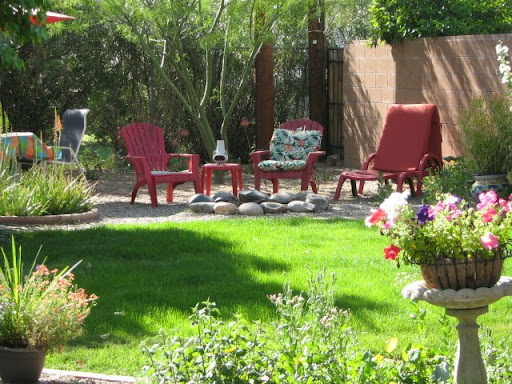I moved to the Valley 12 years ago from Chicago. Gardening was much different there. You put seeds or a plant in the yard or garden and they grew. It rained regular and the soil was rich with organic materials. Never really too hot or sunny. Actually that last part is why I left. I couldn't stand the cold winters and the grey skies.
When I bought my own home in 1998 in Glendale, Arrowhead Ranch Phase 5 (I was proud of that long sub-devision name) I really had no idea how to landscape it. The front landscaping was included. I drove around similar neighborhoods and looked at plants I liked and that's what I picked for my yard. Although my house was the third on the block to be built, by the time the street was built out, we all looked the same.

Back yard was pretty much the same - lots of bouganivillea and lantana. But soon I began to experiment with different plants. Got my first Hibiscus and agave then. Added several other vines and bushes and expanded garden beds and irrigation systems, all kind of helter skelter. Some lived, many died. It was very frustrating and costly.
Several years ago I worked with someone who had a certificate in her office for a Master Gardener program. I was in awe of how easily Rhonda spoke of plants and where they should be planted and when. I wanted some of that for my self!
Four years ago I had the chance to take the Master Gardener program and it changed my life. Not only did it give me more confidence in my own gardens, but I started sharing it with my friends. Soon people were offering to PAY me for my knowledge. They didn't have it and didn't want to go off the learn it themsleves. They wanted ME to come to their house and answer their
questions about specific plant problems or help them re-do or add a garden.
With the encouragement of my friends, I started my one-of-a kind Garden Consulting and Coaching business,
Down 2 Earth Gardens (thanks Robert for helping me create the name).
D2EG provides advice to homeowners on how to reduce the use and dependency of outside resources in their landscape. I create low water and low human energy use designs which are creative and natural. I specialize in working closely with do-it-yourself gardeners and people just starting to use their yard for food production and respite from their busy lives.
I am now doing what I truly love - working with people and the earth. After 25 years in Banking and 10 years in Non-profits, I am doing work I LOVE!
Well now you can apply for and hopefully attend a wonderful program that could change your life as well. The 2010 Master Gardener Program Dates are out!
Jan. 12 - May 4, 2010 (Tuesdays)
9:30 a.m. to 12:30 p.m.
Desert Breeze Police Substation
251 N Desert Breeze Blvd
Chandler, AZ
July 13 - Nov. 2, 2010 (Tuesdays)
9:30 a.m. to 12:30 p.m.
U of A Cooperative Extension, Maricopa County
4341 E Broadway Rd
Phoenix, AZ
Information regarding the class, including the application and maps, can be found at
http://cals.arizona.edu/maricopa/garden/html/mgs/mg-broch.htmThe fee is minimal compared to the knowledge and friendships you will make! I highly recommend you take the program wherever youlive! There are Cooperative Extension Offices throughout the US. Look them up in your part of the country and run, don't walk to the next class near you!
Happy Digging,
Doreen Pollack aka The Garden Goddess
www.down2earthgardens.com



























